Impact of Inductively Coupled Plasma Etching Conditions on the Formation of Semi-Polar (\({11\overline{2}2}\)) and Non-Polar (\({11\overline{2}0}\)) GaN Nanorods
Abstract
:1. Introduction
2. Materials and Methods
3. Results and Discussion
3.1. Effect of Chemistry: Cl2/Ar
3.2. Effect of Pressure
3.3. Effect of Temperature
3.4. Effect of RF Power
3.5. Effect of ICP Power
3.6. Effect of Time
4. Conclusions
Author Contributions
Funding
Data Availability Statement
Conflicts of Interest
References
- Zhao, Y.; Fu, H.; Wang, G.T.; Nakamura, S. Toward ultimate efficiency: Progress and prospects on planar and 3D nanostructured nonpolar and semipolar InGaN light-emitting diodes. Adv. Opt. Photonics 2018, 10, 246–308. [Google Scholar] [CrossRef]
- Monavarian, M.; Rashidi, A.; Feezell, D. A Decade of Nonpolar and Semipolar III-Nitrides: A Review of Successes and Challenges. Phys. Status Solidi A 2019, 216, 1800628. [Google Scholar] [CrossRef] [Green Version]
- Schmidt, M.C.; Kim, K.C.; Sato, H.; Fellows, N.; Masui, H.; Nakamura, S.; DenBaars, S.P.; Speck, J.S. High power and high external efficiency m-plane light emitting diodes. Jpn. J. Appl. Phys. 2007, 46, L126–L128. [Google Scholar] [CrossRef]
- Zhao, Y.; Sonada, J.; Pan, C.C.; Brinkley, S.; Koslow, I.; Fujito, K.; Ohta, H.; DenBaars, S.P.; Nakamura, S. 30-mW-class high-power and high-efficiency blue semipolar (10) InGaN/GaN light-emitting diodes obtained by backside roughening technique. Appl. Phys. Express 2010, 3, 102101. [Google Scholar] [CrossRef] [Green Version]
- Pan, C.C.; Tanaka, S.; Wu, F.; Zhao, Y.; Speck, J.S.; Nakamura, S.; DenBaars, S.P.; Feezell, D. High-power low-efficiency-droop semipolar single-quantumwell blue light-emitting diodes. Appl. Phys. Express 2012, 5, 062103. [Google Scholar] [CrossRef]
- Oh, S.H.; Yonkee, B.P.; Cantore, M.; Farrell, R.M.; Speck, J.S.; Nakamura, S.; DenBaars, S.P. Semipolar III–nitride light-emitting diodes with negligible efficiency droop up to >1W. Appl. Phys. Express 2016, 9, 102102. [Google Scholar] [CrossRef]
- Yamamoto, S.; Zhao, Y.; Pan, C.C.; Chung, R.B.; Fujito, K.; Sonoda, J.; DenBaars, S.P.; Nakamura, S. High-efficiency single-quantum-well green and yellow-green light-emitting diodes on semiopolar (201) GaN substrates. Appl. Phys. Express 2010, 3, 122102. [Google Scholar] [CrossRef]
- Sato, H.; Hirasawa, H.; Asamizu, H.; Fellows, N.; Tyagi, A.; Saito, M.; Fujito, K.; Speck, J.S.; DenBaars, S.P.; Nakamura, S. High power and high efficiency semipolar InGaN light emitting diodes. J. Light Vis. Environ. 2008, 32, 107–110. [Google Scholar] [CrossRef] [Green Version]
- Wang, T. Topical Review: Development of overgrown semipolar GaN for high efficiency green/yellow emission. Semicond. Sci. Technol. 2016, 31, 093003. [Google Scholar] [CrossRef]
- Huh, C.; Lee, K.S.; Kang, E.J.; Park, S.J. Improved light-output and electrical performance of InGaN based light-emitting diode by microroughening of the p-GaN surface. J. Appl. Phys. 2003, 93, 9383–9385. [Google Scholar] [CrossRef] [Green Version]
- Fujii, T.; Gao, Y.; Sharma, R.; Hu, E.L.; DenBaars, S.P.; Nakamura, S. Increase in the extraction efficiency of GaN-based light-emitting diodes via surface roughening. Appl. Phys. Lett. 2004, 84, 855–857. [Google Scholar] [CrossRef]
- David, A.; Benisty, H.; Weisbuch, C. Optimization of Light-Diffracting Photonic-Crystals for High Extraction Efficiency LEDs. J. Disp. Technol. 2007, 3, 133–148. [Google Scholar] [CrossRef]
- Wierer, J.J.; David, A.; Megens, M.M. III-nitride photonic-crystal light-emitting diodes with high extraction efficiency. Nat. Photon. 2009, 3, 163–169. [Google Scholar] [CrossRef]
- Jung, Y.; Kim, J.; Jang, S.; Baik, K.H.; Seo, Y.G.; Hwang, S.-M. Enhanced light extraction of nonpolar a-plane (11-20) GaN light emitting diodes on sapphire substrates by photo-enhanced chemical wet etching. Opt. Express 2010, 18, 9728–9732. [Google Scholar] [CrossRef]
- Baik, K.H.; Song, H.-Y.; Hwang, S.-M.; Jung, Y.; Ahn, J.; Kim, J. Etched Surface Morphology of Heteroepitaxial Nonpolar (1120) and Semipolar (1122) GaN Films by Photoenhanced Chemical Wet Etching. J. Electrochem. Soc. 2011, 158, D196. [Google Scholar] [CrossRef]
- Jung, S.; Song, K.-R.; Lee, S.-N.; Kim, H. Wet Chemical Etching of Semipolar GaN Planes to Obtain Brighter and Cost-Competitive Light Emitters. Adv. Mater. 2013, 25, 4470–4476. [Google Scholar] [CrossRef]
- Zhong, H.; Tyagi, A.; Pfaff, N.; Saito, M.; Fujito, K.; Speck, J.S.; DenBaars, S.P.; Nakamura, S. Enhancing the Light Extraction Efficiency of Blue Semipolar (1011) Nitride-Based Light Emitting Diodes through Surface Patterning. Jpn. J. Appl. Phys. 2009, 48, 030201. [Google Scholar] [CrossRef]
- Solak, H.H.; Dais, C.; Clube, F. Displacement Talbot lithography: A new method for high-resolution patterning of large areas. Opt. Express 2011, 19, 10686–10691. [Google Scholar] [CrossRef]
- Coulon, P.-M.; Kusch, G.; Le Boulbar, E.D.; Chausse, P.; Bryce, C.; Martin, R.W.; Shields, P.A. Hybrid Top-Down/Bottom-Up Fabrication of Regular Arrays of AlN Nanorods for Deep-UV Core-Shell LEDs. Phys. Status Solidi 2017, 6, 599–602. [Google Scholar] [CrossRef] [Green Version]
- Coulon, P.M.; Damilano, B.; Alloing, B.; Chausse, P.; Walde, S.; Enslin, J.; Armstrong, R.; Vézian, S.; Hagedorn, S.; Wernicke, T.; et al. Displacement Talbot lithography for nanoengineering of III-nitride materials. Microsyst. Nanoeng. 2019, 5, 1–12. [Google Scholar] [CrossRef] [Green Version]
- Kima, H.-S.; Yeoma, G.-Y.; Leeb, J.-W.; Kim, T.-I. A study of GaN etch mechanisms using inductively coupled Cl2/Ar plasmas. Thin Solid Films 1999, 341, 180–183. [Google Scholar] [CrossRef]
- Cho, H.; Vartuli, C.B.; Abernathy, C.R.; Donovan, S.M.; Pearton, S.J.; Shul, R.J.; Han, J. Cl2-based dry etching of the AlGAInN system in inductively coupled plasmas. Solid-State Electron. 1998, 42, 2277–2281. [Google Scholar] [CrossRef]
- Okada, N.; Nojima, K.; Ishibashi, N.; Nagatoshi, K.; Itagaki, N.; Inomoto, R.; Motoyama, S.; Kobayashi, T.; Tadatomo, K. Formation of distinctive structures of GaN by inductively-coupled-plasma and reactive ion etching under optimized chemical etching conditions. AIP Adv. 2017, 7, 065111. [Google Scholar] [CrossRef] [Green Version]
- Le Boulbar, E.D.; Lewins, C.J.; Allsopp, D.W.E.; Bowen, C.R.; Shields, P.A. Fabrication of high-aspect ratio GaN nanostructures for advanced photonic devices. Microelectron. Eng. 2016, 153, 132–136. [Google Scholar] [CrossRef] [Green Version]
- Shields, P.; Hugues, M.; Zúñiga-Pérez, J.; Cooke, M.; Dineen, M.; Wang, W.; Causa, F.; Allsopp, D. Fabrication and properties of etched GaN nanorods. Phys. Status Solidi 2012, 9, 631–634. [Google Scholar]
- Jiang, L.; Plank, N.O.V.; Blauw, M.A.; Cheung, R.; Drift, E. Dry etching of SiC in inductively coupled Cl2/Ar plasma. J. Phys. D Appl. Phys. 2004, 37, 1809–1814. [Google Scholar] [CrossRef]
- Shul, R.J.; Zhang, L.; Baca, A.G.; Willison, C.G.; Han, J.; Pearton, S.J.; Ren, F.; Zolper, J.C.; Lester, L.F.; Laboratories, N. High-density plasma-induced etch damage of GaN Mater. Res. Soc. Symp. Proc. 1999, 573, 271–280. [Google Scholar] [CrossRef] [Green Version]
- Cho, H.K.; Khan, F.A.; Adesida, I.; Fang, J.Q.; Look, D.C. Deep level characteristics in n-GaN with inductively coupled plasma damage. J. Phys. D Appl. Phys. 2008, 41, 155314. [Google Scholar] [CrossRef]
- Qiu, R.; Lu, H.; Chen, D.; Zhang, R.; Zheng, Y. Optimization of inductively coupled plasma deep etching of GaN and etching damage analysis. Appl. Surf. Sci. 2011, 257, 2700–2706. [Google Scholar] [CrossRef]
- Coulon, P. Dataset for Impact of Inductively Coupled Plasma Etching Conditions on the Formation of Semi-Polar (11-22) and Non-Polar (11-20) GaN Nanorods; University of Bath Research Data Archive: Bath, UK, in press. [CrossRef]
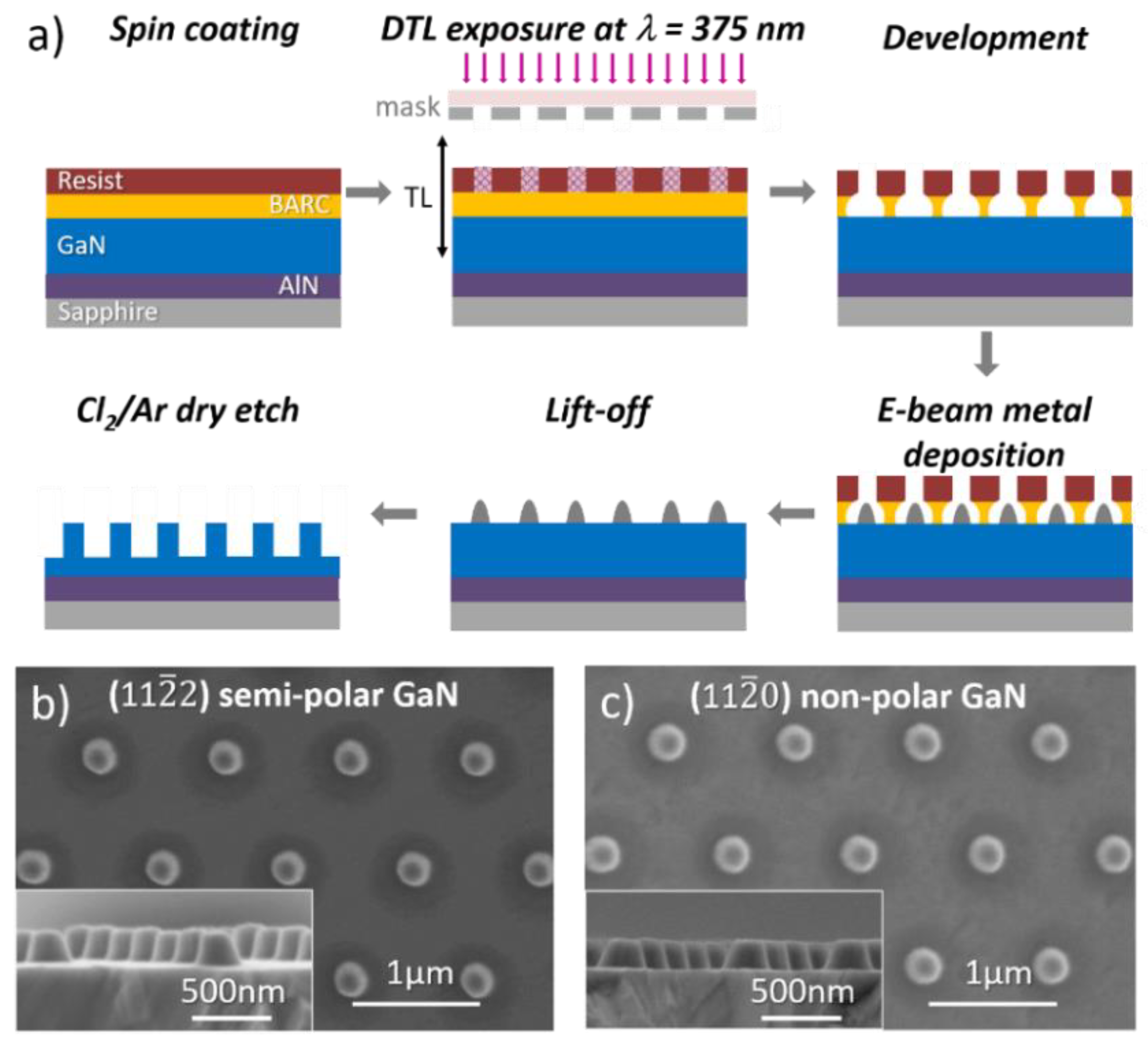
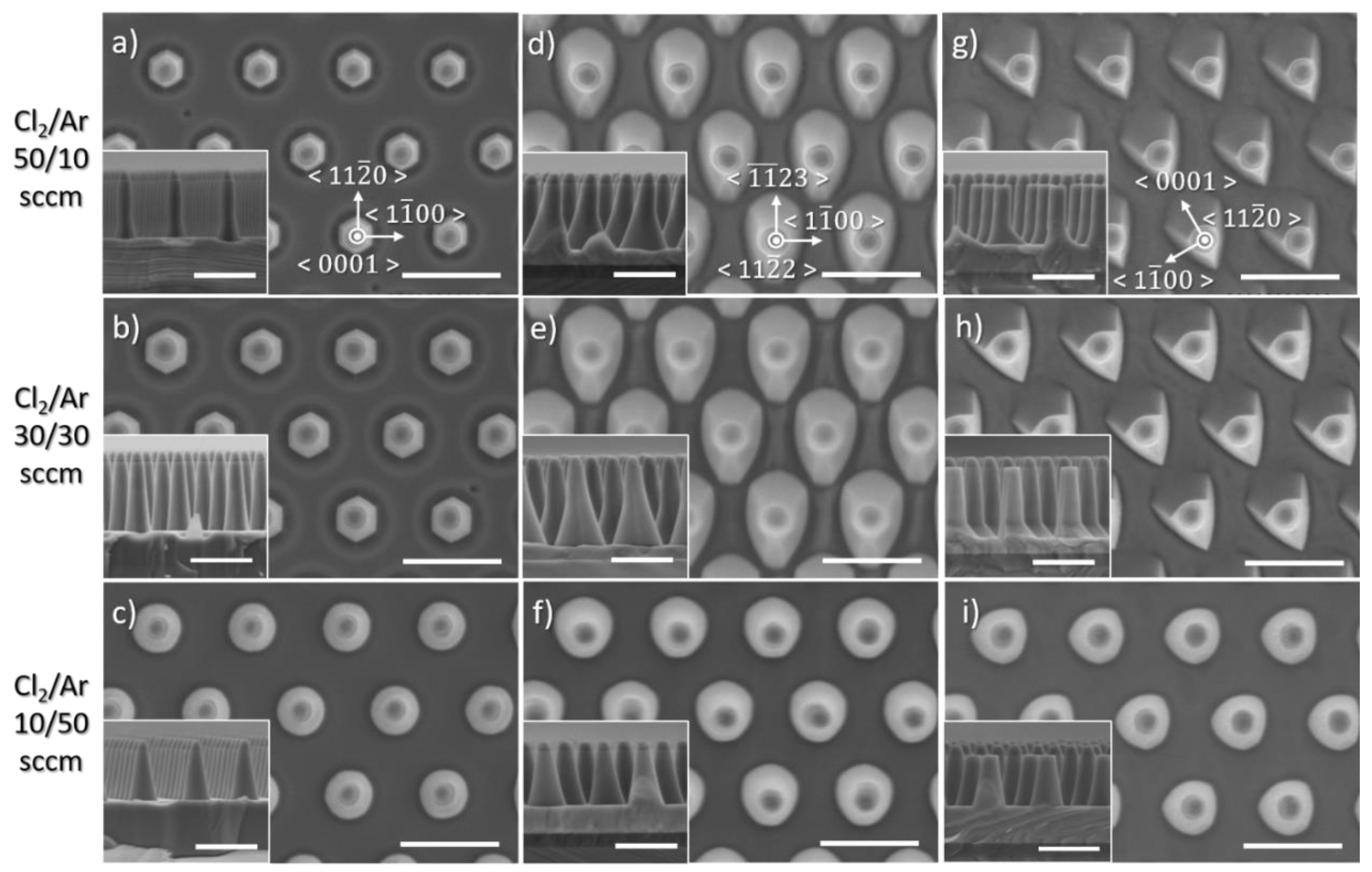

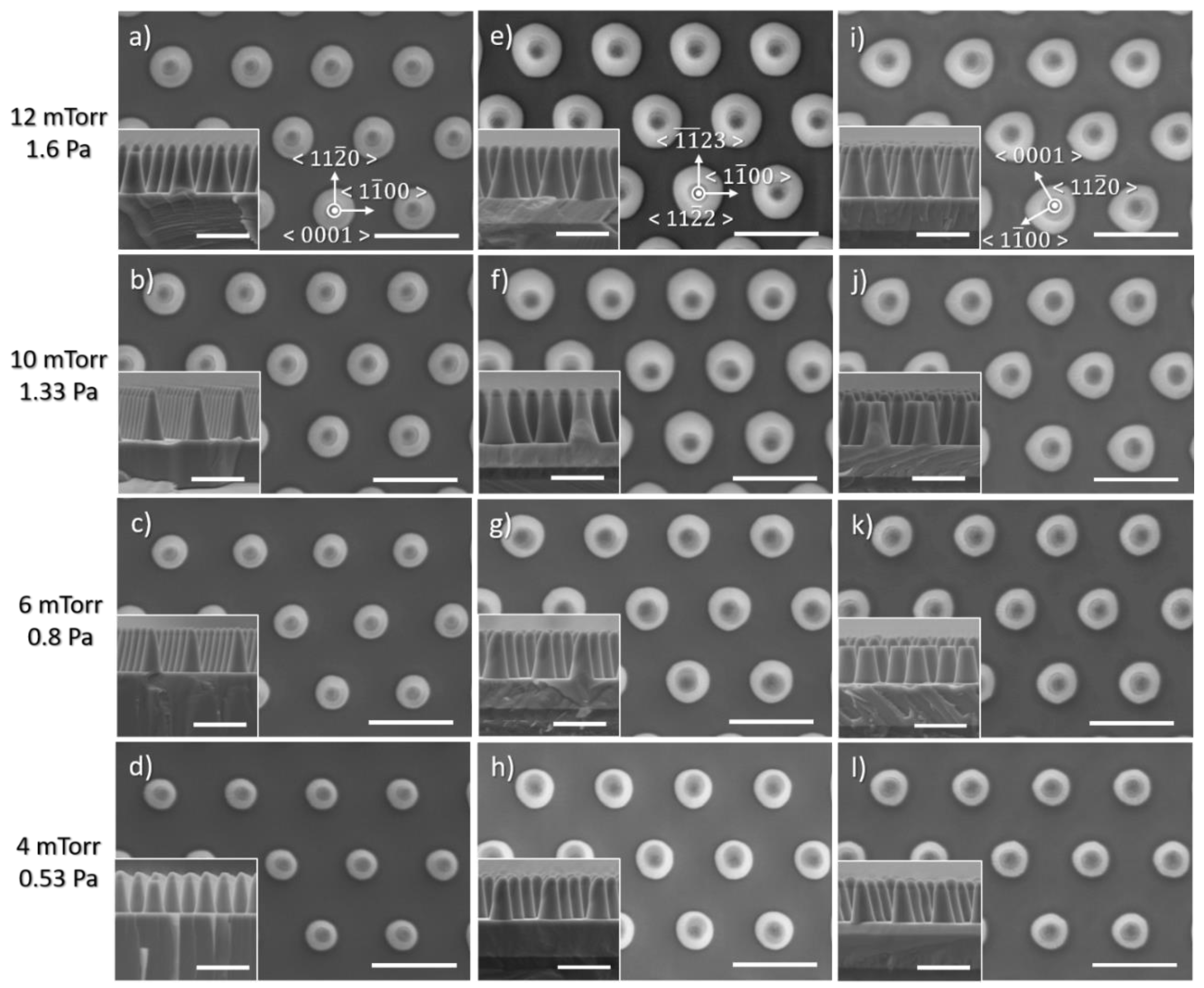

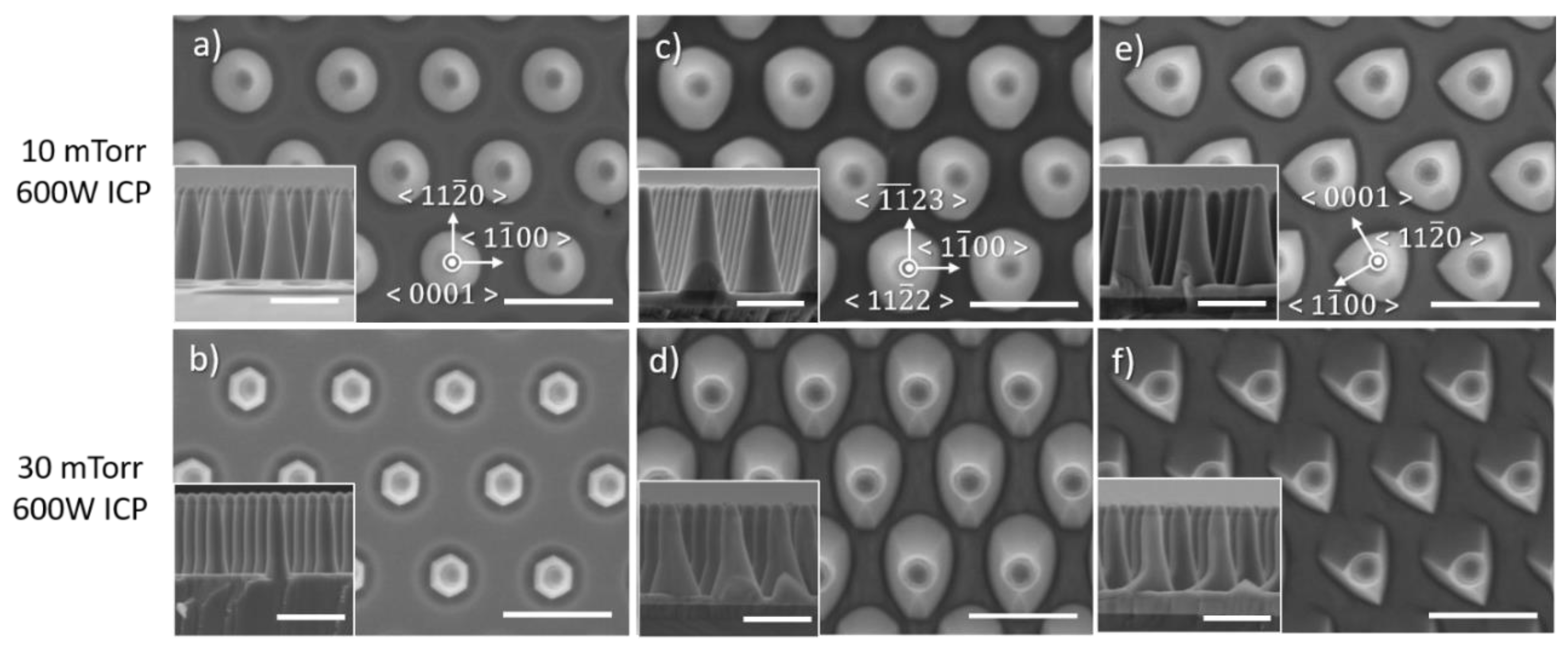
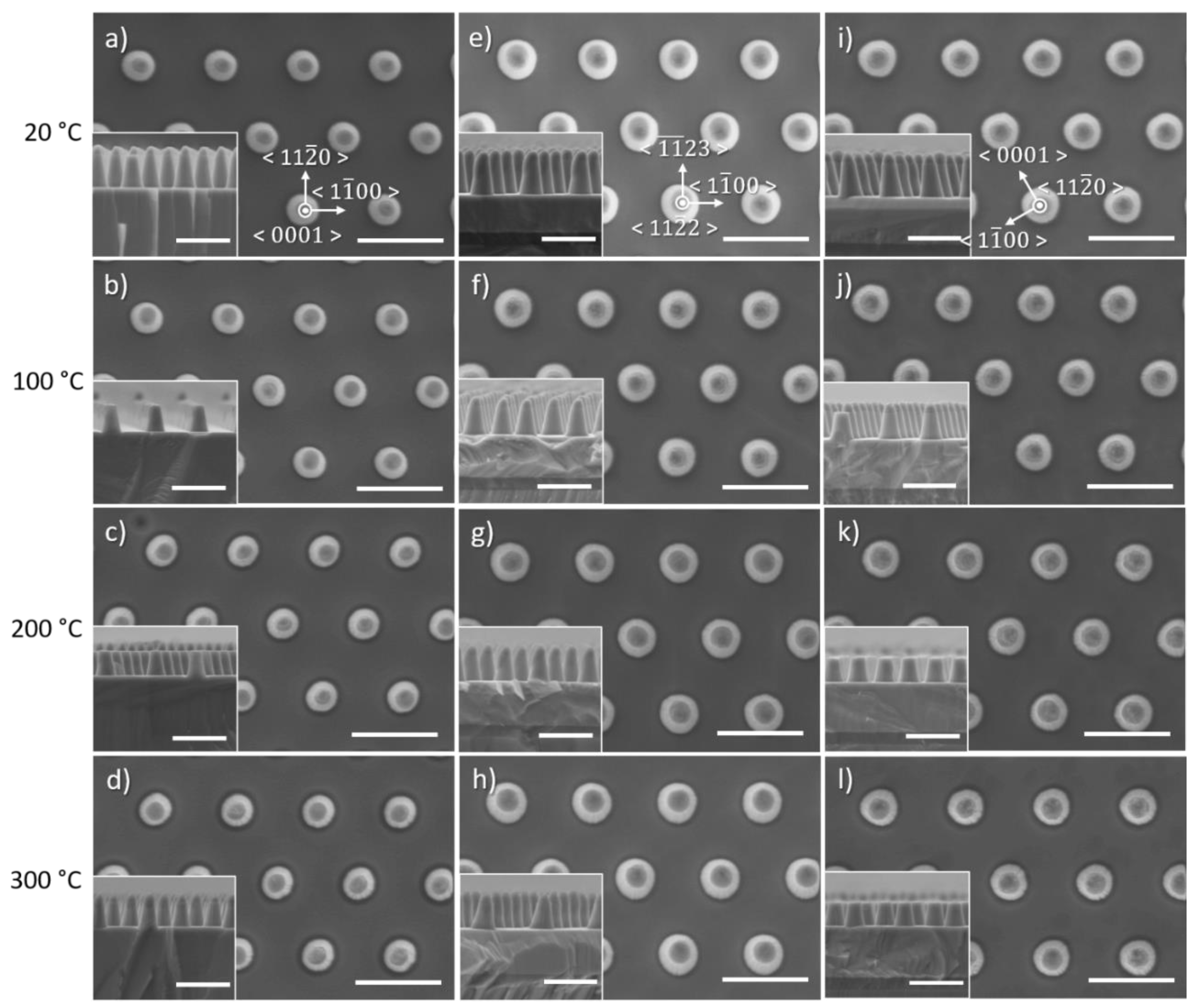

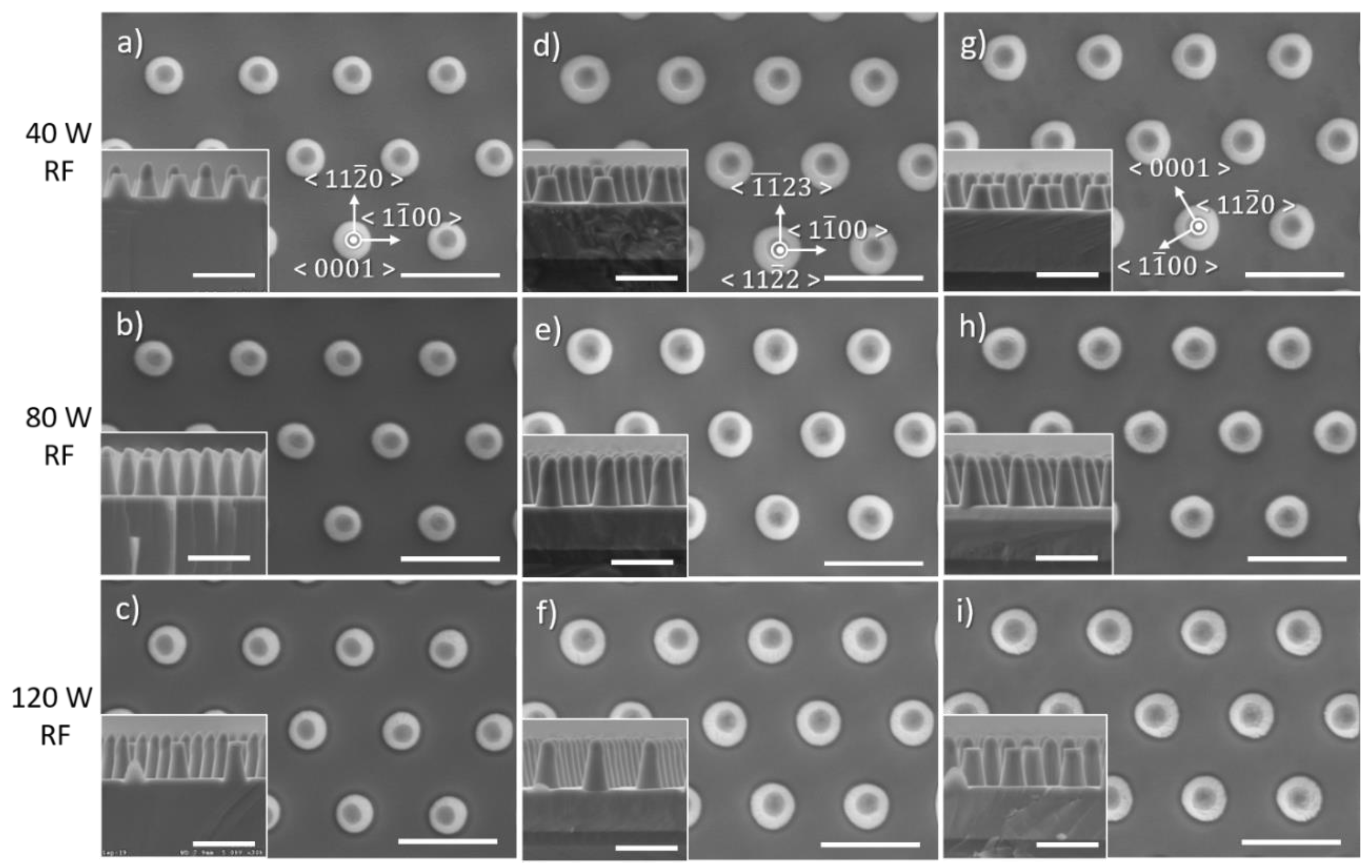



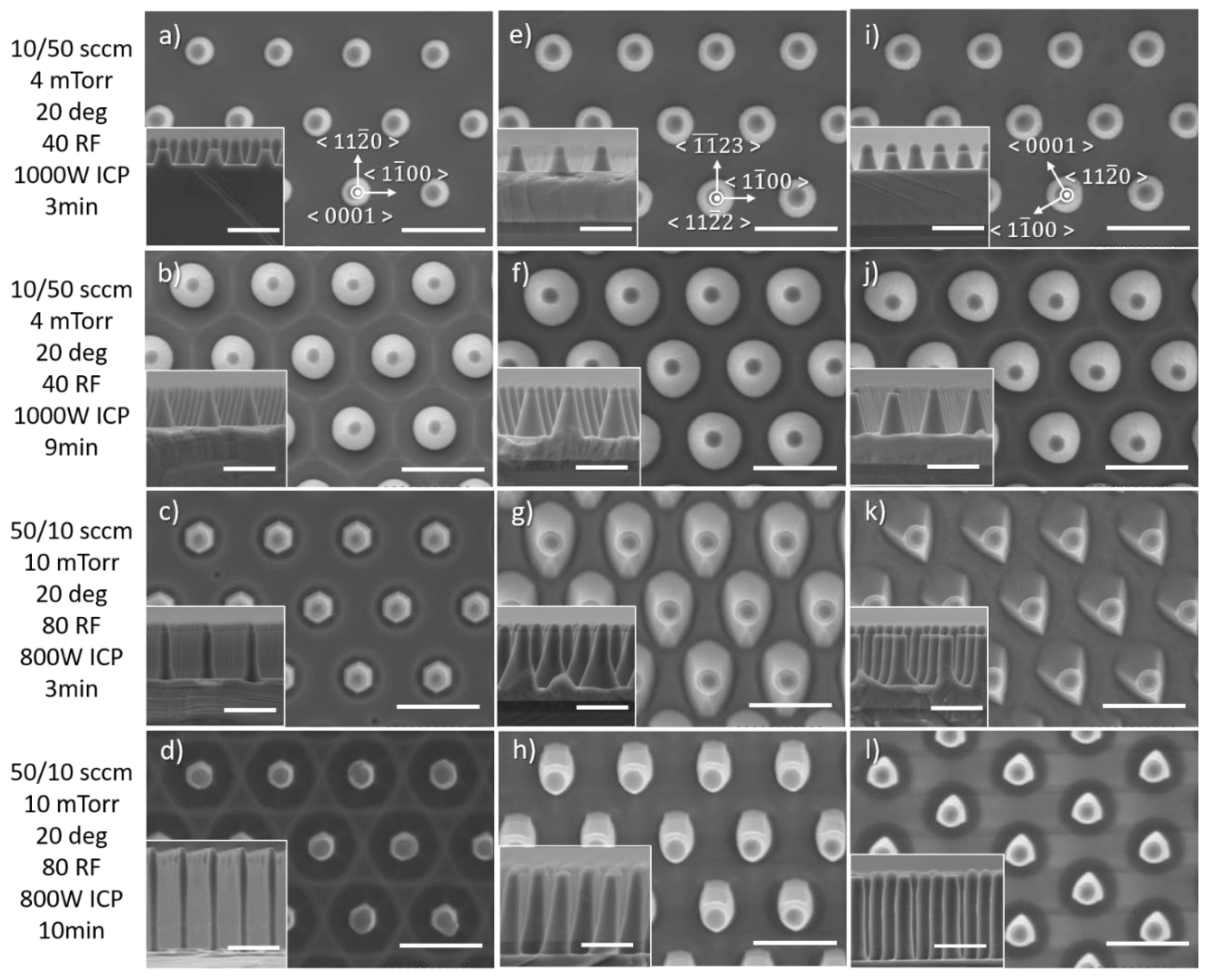
| Etch Series | Cl2/Ar (sccm) | Pressure (mTorr) | Temperature (°C) | RF Power (W) | ICP Power (W) | Time (min) | DC Bias (V) |
|---|---|---|---|---|---|---|---|
| 1 | 50/10–10/50 | 10 | 20 | 80 | 800 | 3 | 325–273 |
| 2 | 10/50 | 12–4 | 20 | 80 | 800 | 3 | 279–240 |
| 3 | 10/50 | 10–30 | 20 | 80 | 600 | 3 | 291–336 |
| 4 | 10/50 | 4 | 20–300 | 80 | 800 | 3 | 240–255 |
| 5 | 10/50 | 4 | 20 | 40–120 | 800 | 3 | 171–329 |
| 6 | 10/50 | 4 | 20 | 40 | 600–1000 | 3 | 187–158 |
| 7 | 10/50 | 4 | 20 | 40 | 1000 | 3–9 | 158 |
| 8 | 50/10 | 10 | 20 | 80 | 800 | 3–10 | 325 |
Publisher’s Note: MDPI stays neutral with regard to jurisdictional claims in published maps and institutional affiliations. |
© 2020 by the authors. Licensee MDPI, Basel, Switzerland. This article is an open access article distributed under the terms and conditions of the Creative Commons Attribution (CC BY) license (http://creativecommons.org/licenses/by/4.0/).
Share and Cite
Coulon, P.-M.; Feng, P.; Wang, T.; Shields, P.A. Impact of Inductively Coupled Plasma Etching Conditions on the Formation of Semi-Polar (\({11\overline{2}2}\)) and Non-Polar (\({11\overline{2}0}\)) GaN Nanorods. Nanomaterials 2020, 10, 2562. https://doi.org/10.3390/nano10122562
Coulon P-M, Feng P, Wang T, Shields PA. Impact of Inductively Coupled Plasma Etching Conditions on the Formation of Semi-Polar (\({11\overline{2}2}\)) and Non-Polar (\({11\overline{2}0}\)) GaN Nanorods. Nanomaterials. 2020; 10(12):2562. https://doi.org/10.3390/nano10122562
Chicago/Turabian StyleCoulon, Pierre-Marie, Peng Feng, Tao Wang, and Philip A. Shields. 2020. "Impact of Inductively Coupled Plasma Etching Conditions on the Formation of Semi-Polar (\({11\overline{2}2}\)) and Non-Polar (\({11\overline{2}0}\)) GaN Nanorods" Nanomaterials 10, no. 12: 2562. https://doi.org/10.3390/nano10122562
APA StyleCoulon, P.-M., Feng, P., Wang, T., & Shields, P. A. (2020). Impact of Inductively Coupled Plasma Etching Conditions on the Formation of Semi-Polar (\({11\overline{2}2}\)) and Non-Polar (\({11\overline{2}0}\)) GaN Nanorods. Nanomaterials, 10(12), 2562. https://doi.org/10.3390/nano10122562





